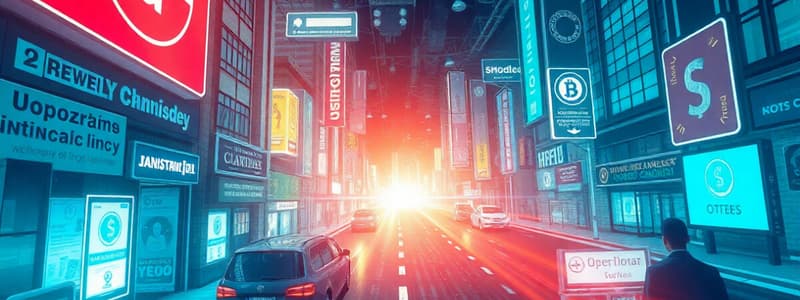Podcast
Questions and Answers
What is a potential consequence of a bank's failure to identify and prevent money laundering?
What is a potential consequence of a bank's failure to identify and prevent money laundering?
- Reduced risk of fraud and economic crimes.
- Expansion of the bank's international reach.
- Improved public confidence in the bank's operations.
- Increased regulatory scrutiny and potential legal action. (correct)
How does globalization impact the risk of money laundering?
How does globalization impact the risk of money laundering?
- It reduces the need for complex financial transactions, simplifying the detection of illicit activities.
- It creates opportunities for criminal activities to access banking and financial systems globally. (correct)
- It decreases global economic interconnectedness, making money laundering less common.
- It fosters increased transparency and accountability in international financial transactions.
What is the primary reason banks and financial institutions are susceptible to money laundering?
What is the primary reason banks and financial institutions are susceptible to money laundering?
- The pressure from high-net-worth individuals to conduct confidential transactions.
- The absence of robust technology platforms to scan transactions.
- The complex nature of global financial transactions and the ease of concealing criminal funds. (correct)
- A lack of regulatory oversight and legal frameworks to address money laundering.
- Inadequate training of employees to identify suspicious financial activities.
What is a significant reputational risk associated with money laundering for financial institutions?
What is a significant reputational risk associated with money laundering for financial institutions?
What is the primary objective of international organizations concerning money laundering?
What is the primary objective of international organizations concerning money laundering?
What is the estimated percentage of global GDP that is laundered annually according to the UN?
What is the estimated percentage of global GDP that is laundered annually according to the UN?
What is the estimated amount of money laundered annually in 2006, according to Buehn and Schneider's study?
What is the estimated amount of money laundered annually in 2006, according to Buehn and Schneider's study?
What is the estimated amount of money laundered annually according to the UN, if money laundering were an economy?
What is the estimated amount of money laundered annually according to the UN, if money laundering were an economy?
According to the provided text, what is a potential consequence of money laundering for a country's political system?
According to the provided text, what is a potential consequence of money laundering for a country's political system?
Why is it difficult to gather reliable data on the extent of money laundering?
Why is it difficult to gather reliable data on the extent of money laundering?
Which of these institutions has NOT attempted to estimate the extent of money laundering, according to the text?
Which of these institutions has NOT attempted to estimate the extent of money laundering, according to the text?
What kind of organizations are most vulnerable to receiving criminal money disguised in the form of genuine business?
What kind of organizations are most vulnerable to receiving criminal money disguised in the form of genuine business?
Which of the following is NOT a common source of illegal money mentioned in the text?
Which of the following is NOT a common source of illegal money mentioned in the text?
Which of the following is NOT a potential impact of money laundering on a country's financial system?
Which of the following is NOT a potential impact of money laundering on a country's financial system?
What is the main purpose of the "layering" stage in money laundering?
What is the main purpose of the "layering" stage in money laundering?
Which of the following is a key characteristic of the "integration" stage in money laundering?
Which of the following is a key characteristic of the "integration" stage in money laundering?
How can financial institutions be involved in the money laundering process?
How can financial institutions be involved in the money laundering process?
What is the primary objective of money laundering?
What is the primary objective of money laundering?
Which of the following is NOT a step in the traditional money laundering cycle?
Which of the following is NOT a step in the traditional money laundering cycle?
Why is the money laundering process often described as complex?
Why is the money laundering process often described as complex?
What is the main difference between money laundering and terrorism financing?
What is the main difference between money laundering and terrorism financing?
Which of the following accurately describes the goal of money laundering, according to the provided text?
Which of the following accurately describes the goal of money laundering, according to the provided text?
According to the Vienna Convention, what is ONE of the methods employed in money laundering?
According to the Vienna Convention, what is ONE of the methods employed in money laundering?
Which international organization defines money laundering as a process to "disguise the illegal origins of their wealth and protect their asset bases"?
Which international organization defines money laundering as a process to "disguise the illegal origins of their wealth and protect their asset bases"?
Based on the text, what is the primary motivation behind the act of money laundering?
Based on the text, what is the primary motivation behind the act of money laundering?
Which of the following is NOT explicitly mentioned as a technique used in money laundering as per the Vienna Convention?
Which of the following is NOT explicitly mentioned as a technique used in money laundering as per the Vienna Convention?
Which of the following organizations defines money laundering as a process to "conceal or disguise the identity of illegally obtained proceeds so that they appear to have originated from legitimate sources?"
Which of the following organizations defines money laundering as a process to "conceal or disguise the identity of illegally obtained proceeds so that they appear to have originated from legitimate sources?"
What is the purpose of money laundering, as presented in the text?
What is the purpose of money laundering, as presented in the text?
Which stage of the money laundering cycle focuses on obscuring the origin of illicit funds?
Which stage of the money laundering cycle focuses on obscuring the origin of illicit funds?
What is a common tactic used by money launderers to avoid detection during the placement stage?
What is a common tactic used by money launderers to avoid detection during the placement stage?
What is the primary goal of the integration stage in the money laundering cycle?
What is the primary goal of the integration stage in the money laundering cycle?
Why is the layering stage considered particularly effective for money laundering?
Why is the layering stage considered particularly effective for money laundering?
What challenge do money launderers face during the placement stage?
What challenge do money launderers face during the placement stage?
How has the advancement of technology benefited money laundering operations?
How has the advancement of technology benefited money laundering operations?
What is a common technique used during the layering stage to obscure the initial source of funds?
What is a common technique used during the layering stage to obscure the initial source of funds?
Which of the following is a significant challenge for money launderers in the integration stage?
Which of the following is a significant challenge for money launderers in the integration stage?
Which of the following was NOT a factor contributing to the collapse of the European Union Bank (EUB)?
Which of the following was NOT a factor contributing to the collapse of the European Union Bank (EUB)?
What was the main issue identified with Riggs Bank in the case of Augusto Pinochet?
What was the main issue identified with Riggs Bank in the case of Augusto Pinochet?
What was the primary issue involved in the Riggs Bank case concerning Teodoro Obiang Nguema Mbasogo, the dictator of Equatorial Guinea?
What was the primary issue involved in the Riggs Bank case concerning Teodoro Obiang Nguema Mbasogo, the dictator of Equatorial Guinea?
Which of these statements BEST describes the common thread linking the EUB, Riggs Bank (Pinochet case), and Riggs Bank (Mbasogo case)?
Which of these statements BEST describes the common thread linking the EUB, Riggs Bank (Pinochet case), and Riggs Bank (Mbasogo case)?
According to the provided content, what is a primary responsibility of a banker in the context of correspondent banking relationships?
According to the provided content, what is a primary responsibility of a banker in the context of correspondent banking relationships?
The case of the European Union Bank (EUB) demonstrates the potential for which of the following risks to bankers?
The case of the European Union Bank (EUB) demonstrates the potential for which of the following risks to bankers?
What crucial lesson can be learned from the cases of Riggs Bank, particularly in relation to the Pinochet and Mbasogo cases?
What crucial lesson can be learned from the cases of Riggs Bank, particularly in relation to the Pinochet and Mbasogo cases?
Based on the content, what actions should bankers take when dealing with potential major shareholders?
Based on the content, what actions should bankers take when dealing with potential major shareholders?
Flashcards
Globalisation of banking
Globalisation of banking
The integration of financial institutions worldwide, facilitating cross-border transactions.
Money laundering
Money laundering
The process of making illegally obtained money appear legitimate.
Reputation risk
Reputation risk
The potential loss of public confidence and trust in a financial institution.
Regulatory action
Regulatory action
Signup and view all the flashcards
Preventive mechanism
Preventive mechanism
Signup and view all the flashcards
Extent of Money Laundering
Extent of Money Laundering
Signup and view all the flashcards
John Walker's Estimate
John Walker's Estimate
Signup and view all the flashcards
IMF Estimate
IMF Estimate
Signup and view all the flashcards
OECD Increase
OECD Increase
Signup and view all the flashcards
UNODC Estimate
UNODC Estimate
Signup and view all the flashcards
Global GDP Impact
Global GDP Impact
Signup and view all the flashcards
Vulnerable Financial System
Vulnerable Financial System
Signup and view all the flashcards
Vienna Convention
Vienna Convention
Signup and view all the flashcards
Concealment of Property
Concealment of Property
Signup and view all the flashcards
Criminal Proceeds
Criminal Proceeds
Signup and view all the flashcards
Illicit Origin
Illicit Origin
Signup and view all the flashcards
Asset Protection
Asset Protection
Signup and view all the flashcards
Criminal Activity Association
Criminal Activity Association
Signup and view all the flashcards
Legitimate Sources
Legitimate Sources
Signup and view all the flashcards
Money Laundering Process
Money Laundering Process
Signup and view all the flashcards
Basic Money Laundering Cycle
Basic Money Laundering Cycle
Signup and view all the flashcards
Placement
Placement
Signup and view all the flashcards
Layering
Layering
Signup and view all the flashcards
Integration
Integration
Signup and view all the flashcards
Terrorism Financing
Terrorism Financing
Signup and view all the flashcards
Common Sources of Illegal Money
Common Sources of Illegal Money
Signup and view all the flashcards
Sensitive Avenues for Money Laundering
Sensitive Avenues for Money Laundering
Signup and view all the flashcards
Cash deposits
Cash deposits
Signup and view all the flashcards
Multiple accounts
Multiple accounts
Signup and view all the flashcards
Cross border transfers
Cross border transfers
Signup and view all the flashcards
Fake deals
Fake deals
Signup and view all the flashcards
Electronic fund transfers
Electronic fund transfers
Signup and view all the flashcards
Correspondent Banks
Correspondent Banks
Signup and view all the flashcards
Asset Forfeiture Laws
Asset Forfeiture Laws
Signup and view all the flashcards
European Union Bank of Antigua
European Union Bank of Antigua
Signup and view all the flashcards
Numbered Accounts
Numbered Accounts
Signup and view all the flashcards
Riggs Bank & Pinochet
Riggs Bank & Pinochet
Signup and view all the flashcards
Riggs Bank & Mbasogo
Riggs Bank & Mbasogo
Signup and view all the flashcards
Tax Haven
Tax Haven
Signup and view all the flashcards
Online Banking
Online Banking
Signup and view all the flashcards
Study Notes
Money Laundering Overview
- Money laundering is a complex process to transform illegal funds into legitimate funds, often involving several steps.
- No reliable data exists on the extent of money laundering, though estimates vary significantly.
- A 1995 estimate placed laundered funds at USD 2.8 trillion, while a 1998 estimate was USD 1.5 trillion (approx. 5% of global GDP).
- More recent figures (2006) estimated laundered funds in 20 OECD countries at USD 603 billion (1.74% of GDP), up from USD 273 billion (1.33% of GDP) in 1995.
- The UN estimates annual money laundering equivalent to 2-5% of global GDP, a figure potentially representing the fifth largest economy globally.
Money Laundering Impact on Financials
- Banks and financial institutions are vulnerable due to the nature of their work and globalisation/technology.
- This vulnerability increases fraud and economic crime risk, impacting financial system stability.
- Risk of reputational damage from association with criminal money, leading to loss of customer trust.
- Stricter regulations and compliance measures are needed to check and control criminal funds.
Money Laundering Definitions
- Various international organizations have defined money laundering.
- The UN Convention (Vienna Convention) defines it as converting/transferring property with the intent of concealing, disguising its illicit origin or assisting those involved.
- Other definitions include the process of disguising the origin of criminal proceeds.
- The FATF defines it as the process of disguising the illegal origin of criminal profits and Interpol describes money laundering as concealing illegally obtained wealth.
Case Studies
- European Union Bank (EUB) (Antigua): The bank, initially marketed as online, accepted customers seeking tax evasion or a money laundering haven. It collapsed quickly.
- Riggs Bank & Pinochet: Riggs Bank allegedly helped Pinochet hide stolen Chilean money(9 million USD).
- Riggs Bank & Mbasogo: Investigations uncovered large withdrawals from Equatorial Guinea's embassy accounts, implicating potential embezzlement of over USD 35 million by the dictator and regime officials.
Money Laundering Process
- Placement: Illegal funds are introduced into the financial system typically through cash deposits or cross-border smuggling.
- Layering: Numerous transactions are used in various accounts across multiple banks to obscure the origin of the funds. This often involves structured transactions designed to evade detection.
- Integration: The laundered funds are then transferred into supposedly legitimate business, often with a seemingly legitimate purpose.
Studying That Suits You
Use AI to generate personalized quizzes and flashcards to suit your learning preferences.




